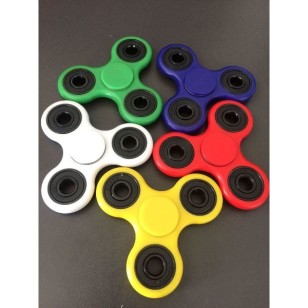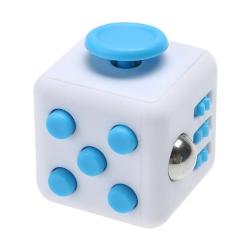
 A recent fad has popped up in my classroom: the fidget toys. Whether it’s a cube or spinner, these little gadgets that grew their following on Kickstarter have become the talk of the class. Kids who have one fall into one of three categories: they have a medical need so the toy helps them focus, they think it’s cool and popular so they want to be on trend, or they follow their friends who have one and claim it helps them focus. I say claim because kids who never had problems focusing before now say they need a gadget. Really?
A recent fad has popped up in my classroom: the fidget toys. Whether it’s a cube or spinner, these little gadgets that grew their following on Kickstarter have become the talk of the class. Kids who have one fall into one of three categories: they have a medical need so the toy helps them focus, they think it’s cool and popular so they want to be on trend, or they follow their friends who have one and claim it helps them focus. I say claim because kids who never had problems focusing before now say they need a gadget. Really?
Now I’m all for the ones who need it because of a ADHD diagnosis, anxiety, or autism or their parents or doctors recommended it. I’ve asked for parental notes if students are bringing one. My fear is that kids are bringing it “just because” and it becomes more of a hindrance than a help. (We all have something that helps them focus. For me, it’s silence and sometimes tapping my pen.) No problem to accommodate as accommodations are what teachers are all about. Gross motor movement is shown to help with memory and retaining information especially for students with ADHD. However, no studies have shown that handheld toys have the same benefit as someone on a stationary bike for memory retention or learning. Ironically, the toy is actually distracting for those with ADHD who are watching other kids play with it.
From the Sentinel & Enterprise news, “According to Laura Garofoli, Fitchburg State University professor of psychological science, said there’s little evidence these fidgeting devices help children with ADHD. ‘There’s no research on the actual fidget spinners yet,’ she said. “Research on fidgets for kids on their desk at school is actually very spotty.”
Garofoli said studies show physical activity helps children with ADHD concentrate, but most research focuses on the use of large muscle groups, not fine motor skills.
“Across the board more physical activity leads to better outcomes for kids with ADHD in the class,” she said. “The tricky part is does that have any correlation with the fine motor of the little fidgets at the desk? Stress balls, TheraPutty — there just isn’t a whole heck of a lot of data to support that they’re effective.”
Hence, my concern is for the ones who are getting them “just because.” (I’ve always taught my students to think for themselves and not be sheep, but that’s for another post.) I’ve asked some students and they don’t exactly know why they have one or want one other than “it’s fun” or “it’s cool.” The problem arises when they start clicking and spinning during lessons and they focus on how much they can click in a minute or how fluently they spin this newly discovered gadget rather than focusing on the lesson. I’ve observed kids walk around the room to visit other kids to see how their spinner works and to challenge each other on how long they can spin. Kids easily miss the important steps to a math problem or what figurative language is when focused on their gadget. They don’t hear all the instructions or miss the assignment due date. It’s also become a distraction to others. I’ve watched students play with their toy during a work period and I’ve seen other kids watch kids as they play. Heck, I get distracted at times and I have enough to do. I now have a new job on my list which is observing who is using the toy for need or for fun. Minutes spent here and there adds up to a lot of wasted minutes in my book and anyone who knows me knows that I’m all about efficiency.
At the end of 2016, Forbes even called it the “must have office toy for 2017.” Be that as it may, some adults may have already established great work habits and can afford to use a spinner while leading a meeting or being on an international conference call. Some schools have banned this toy because of students playing with the toy instead of listening in class. Young kids are just developing these habits and this spinner fad has sort of blown up not necessarily for the better. I’m pretty sure most of my class did not develop a medical condition over the past two weeks that requires said gadget.
A few other students in the school have these toys (this is exactly what it is to me), but I have about a quarter of my class with these colourful contraptions. Hopefully, the students who need one find it helpful and really does keep their attention on the task at hand. I hope the ones who are using one are doing so for a good reason. I want my students to develop good learning and study habits and it’s near the end of the year. E.Q.A.O. (provincial standardized testing) is at the end of the month. We want all the focus we can get and it all starts with parents knowing which toys are being brought into the classroom.
Reference: http://www.sentinelandenterprise.com/news/ci_30956192/spin-spin-argh
Omg, YES!!! This was so helpful to read & you articulated my feelings on these darn things. Everyone in my house has ADHD (some inattentive, some hyper — it’s a lively place…) I have one son in 3rd grade & one in 2nd and both have been officially diagnosed with ADHD. I do not let them take their fidget toys to school. I didn’t even know these were “a thing” until the past week or so. My 3rd grader (my hyper ADHD kid) is obsessed with these cubes & weighted discs that his classmates “all” have. I have no idea whether these kids legitimately need them or not, but their presence in the class is NOT helping my kid. At. All. He fixates on them & when he bought a disc with his own money I told him he could not take it to school. It’s been nothing but a distraction for him in the classroom & when I watch him play with it at home (i tried it out while he did homework) it did not appear to help him focus and only hindered. He took 3xs as long to get through his math sheet. Perhaps they help some people but I need to see the research before I see these as anything other than a gimmick. Ten minutes of active outdoor time is much more helpful for my kids and me. Thank you again for sharing your experiences. I can not begin to imagine trying to teach anything with kids clicking and spinning all over the place.
LikeLike
Thanks for sharing your thoughts. I FULLY advocate the use when necessary, but they are more toys than learning tools at times. I’m happy to see that as a parent, you FULLY get it! 😁
LikeLiked by 1 person
I got my 12 year old son a fidget cube to see if it helps with his ADD during homework/study time and I have to say I think it’s worked. I was skeptical at first because it looked like another fad toy, but he and I both think it’s helping him stay focused on the task in front of him.
LikeLike
I really agree with this post but I would like to just add that when I was in school I could listen better to the teacher when I was doodling, I find my mind wanders way to easily and having something to occupy my hands makes it easier for me to concentrate- I had a relatively mild anxiety problem in high school but never really had a diagnosable problem. Also people with disorders a lot of other disorders can find them helpful. The issue I think they have is that the fidget cube was literally designed to be a less annoying way for people to fidget, not to try stop fidgeting but to control it (thats why the fidget cube has silent buttons as well as clicky ones) I think the focus needs to be on ‘if you feel you need it, great, use it, but if you’re being distracting with it you can’t use it’. People who really have attention problems can just wiggle the joystick from in their pocket, spin the gears or fiddle with the roller ball, all things that are quiet and subtle. The spinners aren’t helpful in a classroom setting because they’re not subtle and can really just take away from everyones ability to learn!
LikeLike